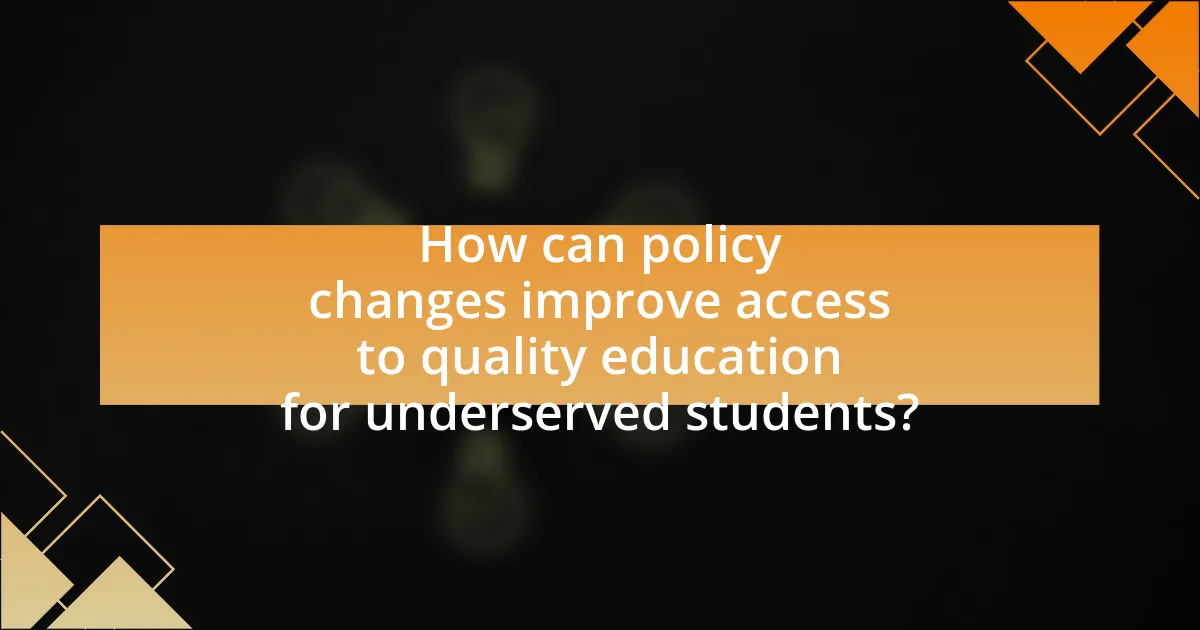The article focuses on how policy changes can enhance access to quality education for underserved students. It outlines the current barriers these students face, including inadequate funding, lack of experienced teachers, and insufficient resources, which are exacerbated by socioeconomic factors and geographic location. The discussion emphasizes the necessity of policy reforms, such as equitable funding models and targeted initiatives, to address systemic inequities and improve educational outcomes. Additionally, it highlights the importance of teacher training, stakeholder engagement, and monitoring strategies to ensure effective implementation of these policies, ultimately aiming to foster educational equity and community development.

How can policy changes improve access to quality education for underserved students?
Policy changes can improve access to quality education for underserved students by reallocating funding to schools in low-income areas, ensuring equitable resources and support. For instance, the Every Student Succeeds Act (ESSA) emphasizes state accountability systems that require schools to address achievement gaps, thereby directing resources to underserved populations. Additionally, policies that promote teacher training and retention in high-need areas can enhance educational quality, as evidenced by studies showing that effective teachers significantly impact student outcomes. Furthermore, implementing universal pre-K programs can provide early educational opportunities, which research indicates leads to better long-term academic performance for disadvantaged students.
What are the current barriers to quality education for underserved students?
Current barriers to quality education for underserved students include inadequate funding, lack of access to experienced teachers, and insufficient educational resources. In many low-income areas, schools receive significantly less funding compared to those in affluent neighborhoods, leading to overcrowded classrooms and limited extracurricular activities. Additionally, underserved students often face a shortage of qualified teachers, as experienced educators may be less willing to work in challenging environments. Furthermore, these students frequently lack access to essential resources such as textbooks, technology, and safe learning environments, which are critical for academic success. According to the National Center for Education Statistics, schools in high-poverty areas are more likely to have lower graduation rates and fewer advanced placement courses, highlighting the systemic inequities that hinder quality education for these students.
How do socioeconomic factors impact educational access?
Socioeconomic factors significantly impact educational access by influencing the availability of resources, opportunities, and support systems for students. Families with lower income levels often face barriers such as inadequate funding for schools, limited access to technology, and fewer extracurricular programs, which can hinder students’ educational experiences. For instance, a report by the National Center for Education Statistics indicates that schools in low-income areas receive about $1,200 less per student compared to those in wealthier districts, leading to disparities in educational quality and access. Additionally, socioeconomic status affects parental involvement, as parents with lower education levels may lack the knowledge or resources to advocate effectively for their children’s education, further exacerbating the gap in access to quality education.
What role does geographic location play in educational disparities?
Geographic location significantly influences educational disparities by determining access to resources, quality of schools, and socioeconomic conditions. For instance, urban areas often have more funding and better facilities compared to rural regions, leading to differences in educational quality. According to the National Center for Education Statistics, schools in low-income areas, which are frequently located in rural or underserved urban neighborhoods, receive about $1,200 less per student than those in affluent areas. This funding gap directly impacts teacher salaries, class sizes, and availability of advanced coursework, contributing to unequal educational outcomes.
Why are policy changes necessary for enhancing educational access?
Policy changes are necessary for enhancing educational access because they address systemic barriers that prevent underserved students from receiving quality education. These barriers include inadequate funding, discriminatory practices, and lack of resources, which policy reforms can effectively target. For instance, the Every Student Succeeds Act (ESSA) of 2015 aimed to improve educational outcomes by ensuring equitable funding and resources for low-income schools, demonstrating that legislative changes can lead to increased access and improved educational equity.
What evidence supports the need for policy reform in education?
Evidence supporting the need for policy reform in education includes significant disparities in educational outcomes among different demographic groups. For instance, the National Assessment of Educational Progress (NAEP) reports that students from low-income families score, on average, 25 points lower in reading and math compared to their higher-income peers. Additionally, a study by the Education Trust found that schools serving predominantly students of color receive $23 billion less in funding than those serving mostly white students. These statistics highlight the urgent need for policy changes to address inequities and ensure that all students have access to quality education.
How can policy changes address systemic inequities in education?
Policy changes can address systemic inequities in education by implementing equitable funding models that allocate resources based on student needs rather than property taxes. For instance, states like Massachusetts have adopted weighted funding formulas that provide additional financial support to schools serving low-income students, resulting in improved educational outcomes. Additionally, policies that promote inclusive curricula and culturally responsive teaching can help bridge gaps in student engagement and achievement, as evidenced by research from the National Education Association, which shows that culturally relevant pedagogy enhances student performance. By prioritizing these changes, policymakers can create a more equitable educational landscape that supports all students effectively.

What specific policy changes can enhance educational access?
Specific policy changes that can enhance educational access include increasing funding for low-income schools, implementing universal pre-K programs, and expanding access to technology and internet resources. Increased funding for low-income schools can provide necessary resources, such as qualified teachers and updated materials, which are essential for quality education. Universal pre-K programs have been shown to improve long-term educational outcomes by ensuring that all children have a strong foundation before entering elementary school. Additionally, expanding access to technology and internet resources addresses the digital divide, enabling students from underserved communities to engage with online learning and educational tools effectively. Research indicates that these policy changes can significantly improve educational access and outcomes for underserved students, as evidenced by studies showing improved performance in schools with adequate funding and resources.
How can funding reforms improve educational resources for underserved students?
Funding reforms can significantly enhance educational resources for underserved students by reallocating financial support to schools that need it most. These reforms can address disparities in funding that often leave low-income schools with inadequate resources, such as outdated textbooks, insufficient technology, and limited extracurricular programs. For instance, a study by the Education Trust found that schools serving predominantly low-income students receive about $1,000 less per student than their wealthier counterparts, which directly impacts the quality of education provided. By implementing funding reforms that prioritize equitable distribution, states can ensure that underserved students have access to essential educational tools and opportunities, thereby improving their academic outcomes and overall school experience.
What are the implications of equitable funding models?
Equitable funding models lead to improved educational outcomes for underserved students by ensuring that resources are allocated based on need rather than local wealth. These models address disparities in funding that often disadvantage low-income communities, enabling schools to provide better facilities, qualified teachers, and essential support services. Research indicates that states implementing equitable funding formulas have seen increases in student achievement and graduation rates, demonstrating the effectiveness of these models in leveling the playing field. For instance, a study by the Education Trust found that equitable funding can significantly reduce achievement gaps, particularly in districts serving high percentages of low-income students.
How can targeted funding initiatives support specific student needs?
Targeted funding initiatives can support specific student needs by allocating resources directly to programs that address educational disparities. For instance, initiatives that provide financial aid for low-income students can enhance access to necessary learning materials and technology, which are critical for academic success. According to the National Center for Education Statistics, schools with targeted funding often report improved student performance and engagement, particularly among underserved populations. By focusing on specific needs, such as mental health services or tutoring programs, targeted funding can create tailored support systems that foster a more equitable educational environment.
What role do teacher training and support policies play in educational access?
Teacher training and support policies are crucial in enhancing educational access by ensuring that educators are equipped with the necessary skills and resources to effectively teach diverse student populations. Well-structured training programs improve teachers’ pedagogical methods, cultural competency, and ability to address the unique needs of underserved students. For instance, research from the National Center for Education Statistics indicates that schools with comprehensive teacher training programs report higher student achievement levels, particularly among disadvantaged groups. Additionally, support policies, such as mentorship and ongoing professional development, foster a collaborative environment that encourages teachers to share best practices and adapt to the challenges faced by their students. This alignment of training and support directly correlates with increased educational access, as it empowers teachers to create inclusive and effective learning environments.
How can professional development improve teaching quality in underserved areas?
Professional development can significantly improve teaching quality in underserved areas by equipping educators with effective instructional strategies and resources tailored to diverse student needs. Research indicates that targeted professional development programs, such as those focusing on culturally responsive teaching and differentiated instruction, lead to enhanced teacher efficacy and student engagement. For instance, a study by the National Center for Education Statistics found that teachers who participated in ongoing professional development reported higher levels of confidence in their teaching abilities, which correlated with improved student performance in low-income schools. By fostering a continuous learning environment, professional development helps educators adapt to the unique challenges of underserved areas, ultimately leading to better educational outcomes for students.
What policies can incentivize teachers to work in high-need schools?
Policies that can incentivize teachers to work in high-need schools include financial incentives such as higher salaries, student loan forgiveness programs, and signing bonuses. Research indicates that competitive compensation can attract qualified educators to underserved areas, as evidenced by a study from the National Center for Education Statistics, which found that schools in high-poverty areas often struggle to retain teachers due to lower pay compared to their counterparts in affluent districts. Additionally, providing professional development opportunities and support systems can enhance job satisfaction and retention, further encouraging teachers to commit to high-need schools.

What are the potential outcomes of effective policy changes?
Effective policy changes can lead to improved access to quality education for underserved students. These outcomes include increased enrollment rates, enhanced educational resources, and better student performance. For instance, research by the National Center for Education Statistics shows that targeted funding and resource allocation can significantly reduce achievement gaps among disadvantaged groups. Additionally, policies that promote equitable funding models have been linked to higher graduation rates, as evidenced by studies from the Education Trust, which highlight the correlation between funding equity and student success.
How can improved access to quality education impact student outcomes?
Improved access to quality education significantly enhances student outcomes by increasing academic achievement and fostering critical thinking skills. Research indicates that students who attend well-resourced schools with qualified teachers are more likely to perform at higher academic levels, as evidenced by standardized test scores. For instance, a study by the National Center for Education Statistics found that students in schools with better funding and resources scored, on average, 20% higher on math assessments compared to those in underfunded schools. Furthermore, access to quality education promotes higher graduation rates; data from the U.S. Department of Education shows that students in high-quality educational environments are 30% more likely to graduate on time. This correlation underscores the importance of equitable educational policies aimed at improving access for underserved populations, ultimately leading to better long-term socioeconomic outcomes for these students.
What are the long-term benefits of educational equity for students?
The long-term benefits of educational equity for students include improved academic achievement, increased graduation rates, and enhanced career opportunities. When students have equal access to quality education, they are more likely to perform better academically, as evidenced by studies showing that equitable funding and resources lead to higher test scores and grades. Additionally, equitable education systems contribute to higher graduation rates; for instance, research from the National Center for Education Statistics indicates that schools with equitable practices see a significant increase in the number of students who complete their high school education. Furthermore, students who experience educational equity are better prepared for the workforce, as they acquire the necessary skills and knowledge, leading to higher employment rates and better job prospects in adulthood.
How does access to quality education influence community development?
Access to quality education significantly influences community development by fostering economic growth, reducing poverty, and enhancing social cohesion. Quality education equips individuals with essential skills and knowledge, leading to better job opportunities and increased earning potential. For instance, a study by the Organisation for Economic Co-operation and Development (OECD) found that each additional year of schooling can increase an individual’s income by approximately 10%. Furthermore, educated individuals are more likely to engage in civic activities, volunteerism, and community service, which strengthens social bonds and promotes a sense of belonging. This collective engagement contributes to safer, more resilient communities, ultimately driving sustainable development.
What best practices can be implemented to ensure successful policy changes?
Successful policy changes can be ensured by engaging stakeholders throughout the process. Engaging stakeholders, including educators, parents, and community members, fosters collaboration and builds trust, which is essential for the acceptance and implementation of new policies. Research indicates that inclusive decision-making leads to higher satisfaction and better outcomes; for instance, a study by the National Education Association found that policies developed with stakeholder input are more likely to be effectively implemented and sustained. Additionally, providing clear communication about the changes and their benefits helps to mitigate resistance and encourages buy-in from all parties involved.
How can stakeholder engagement enhance policy effectiveness?
Stakeholder engagement enhances policy effectiveness by ensuring that diverse perspectives and needs are considered in the policy-making process. When stakeholders, such as educators, parents, and community members, actively participate, they provide valuable insights that can lead to more relevant and targeted policies. For instance, research by the National Education Association indicates that policies developed with stakeholder input are more likely to address the specific challenges faced by underserved students, resulting in improved educational outcomes. Engaging stakeholders also fosters greater buy-in and support for policies, which can facilitate smoother implementation and adherence, ultimately leading to more successful educational initiatives.
What strategies can be used to monitor and evaluate policy impacts?
To monitor and evaluate policy impacts, strategies such as establishing clear metrics, conducting regular assessments, and utilizing stakeholder feedback are essential. Clear metrics allow for quantifiable measurements of policy outcomes, while regular assessments, such as longitudinal studies, provide insights over time. Stakeholder feedback, including input from educators and students, ensures that the evaluation process captures diverse perspectives and real-world implications. For instance, the use of standardized test scores and graduation rates can serve as concrete metrics to assess educational policies aimed at improving access for underserved students.
What actionable steps can advocates take to promote policy changes?
Advocates can promote policy changes by engaging in grassroots mobilization, building coalitions, and leveraging data to support their initiatives. Grassroots mobilization involves organizing community members to raise awareness and demonstrate public support for educational reforms, which can influence policymakers. Building coalitions with other organizations amplifies the advocacy efforts, as seen in successful campaigns like the “Every Student Succeeds Act,” where diverse groups united to push for equitable education policies. Additionally, leveraging data, such as statistics on educational disparities, provides concrete evidence to policymakers about the need for change, making arguments more compelling. For instance, research from the National Center for Education Statistics shows that underserved students often face significant achievement gaps, underscoring the urgency for policy interventions.



